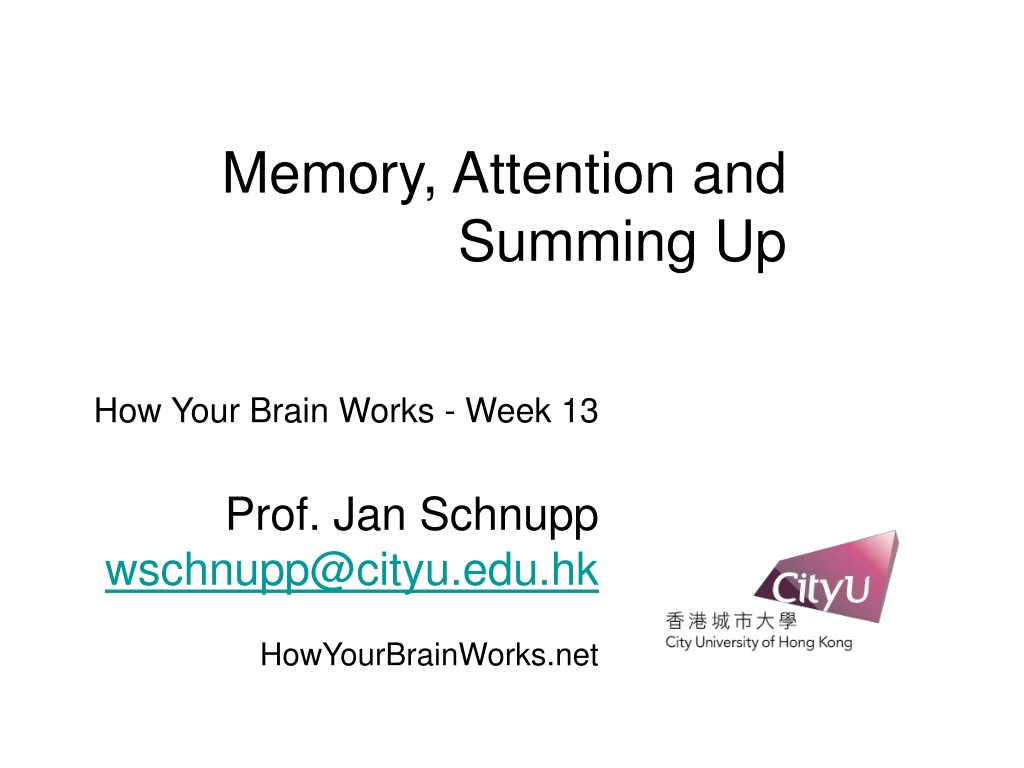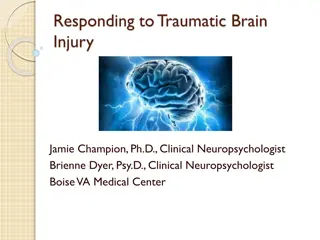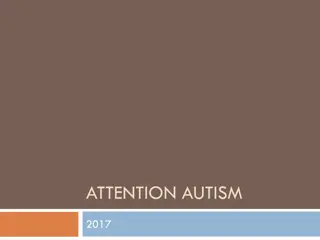Understanding How Your Brain Works: Memory, Attention, and Processing
Delve into the intricate workings of memory, attention, and cognitive processing in the brain as explored by Prof. Jan Schnupp. Discover the various types of memory, including short-term and long-term, procedural, declarative, and more. Explore the concept of working memory and its neuronal mediation as illustrated through experiments. Gain insights into forming long-term memories with synaptic plasticity and the distinction between ITC and PFC neurons. Unravel the mechanisms behind memory categorization, neuron activity in response to stimuli, and the storage of last seen images in memory. Dive deeper into the fascinating world of patient H.M. and the complexities of declarative and spatial memories.
Download Presentation

Please find below an Image/Link to download the presentation.
The content on the website is provided AS IS for your information and personal use only. It may not be sold, licensed, or shared on other websites without obtaining consent from the author. Download presentation by click this link. If you encounter any issues during the download, it is possible that the publisher has removed the file from their server.
E N D
Presentation Transcript
Memory, Attention and Summing Up How Your Brain Works - Week 13 Prof. Jan Schnupp wschnupp@cityu.edu.hk HowYourBrainWorks.net
Types of Memory Memory Short Term or Working Long Term Procedural Declarative Visuo-Spatial Phonological Semantic Episodic
Working Memory Working memory is thought to be mediated by sustained activity of neurons in prefrontal cortex (PFC) as illustrated in the experiment by Freedman et al discussed over the next few slides.
D J Freedman et al. Science 2001;291:312-316, Figure 2: Task design and behavior. Monkeys were trained to categorize computer images of cats or dogs in a delayed match-to-sample task. To vary difficulty, the images could be morphed to be, say, 70% dog and 30% cat. (A) A sample was followed by a delay and a test stimulus. If the sample and test stimulus were the same category (a match), monkeys had to release a lever before the test disappeared. Otherwise, there was another delay followed by a match. Equal numbers of match and non-match trials were randomly interleaved. (B) Average performance of both monkeys. Red and blue bars indicate percentages of samples classified as dog and cat, respectively.
D J Freedman et al (2001)Figure 3B: The average activity of a single neuron in response to stimuli at the six morph blends. The vertical lines correspond (from left to right) to sample onset, offset, and test stimulus onset. The inset shows the neuron's delay activity in response to stimuli along each of the nine between-class morph lines. The prototypes (C1, C2, C3, D1, D2, and D3) are represented in the outermost columns; each appears in three morph lines. A color scale indicates the activity level.
Comparing ITC and PFC Neurons in the infratemporal cortex (ITC) had learned to distinguish the picture categories. They are active when the stimulus is present. Neurons in the PFC hold the last seen picture in memory. Their activities are different from the end of stimulus presentation until the monkey responds.
Forming Long Term Memories with Synaptic Plasticity
Long-term Memory For procedural type learning and memory, see last lecture. For declarative and spatial memories, welcome to the world of patient H.M. :
Patient HM Henry Molaison had his hippocampus removed bilaterally in 1953 to treat severe epilepsy. He died in 2008.
Patient HM The surgery successfully cured his epilepsy, but left him with severe anterograde amnesia. He could no longer form new episodic memories. For example, he would not be able to remember people he met just hours before. He could not learn new landmarks to help him orient in a new environment. But his ability for procedural learning remained in tact. He learned to play ping-pong after his surgery. Could not remember ever having played it, but became quite good at it.
What does the hippocampus do? The hippocampus probably has limbic roles related to anxiety and depression too, but in this lecture we focus on episodic and spatial memory roles. It is generally thought that Long Term Potentiation (LTP) following Hebb s Rule is an essential ingredient for the hippocampus key role in memory formation.
Hebbs Rule Cells that fire together, wire together Psychologist Donald Hebb first suggested that connections between neurons that are simultaneously active might be strengthened. This is advantageous for associative learning . (Associations form between things that are simultaneously signalled in the brain.) Strengthening (or long-term potentiation - LTP) of simultaneously activated synapses has been observed in hippocampus (and later many other brain structures).
Structure of the hippocampus Hippocampus receives high level multisensory information via enthorinal cortex (EC) Inputs go to dentate gyrus (DG), then cornus ammonis (CA) region 3 then CA1 and then back to EC via the subiculum. The synapses are glutamatergic and plastic.
Inputs and outputs from hippo- campus
An Example of Hippocampal LTP Time (min) Time (min) EPSPs recorded in hippocampal CA1 cell. 100 Hz stimulus bursts applied to Schaeffer collateral inputs, either under voltage clamp or with simultaneous depolarisation. If the input bursts are paired with depolarisation, the EPSPs are potentiated (i.e. larger).
The NMDA Receptor NMDA receptors appear to be critically involved in LTP at glutamatergic synapses. NMDA receptor channels open only if glutamate binds AND depolarisation removes a Mg++ from the channel s pore. This implements Hebb s rule. The postsynaptic neuron must be active already for the synapse to be modified. Drugs that block the NMDA receptor (AP-5, MK-801, ketamine) prevent LTP.
NMDA receptor activation lets Ca++ in Dendrite filled with Ca++ indicator calcium green emits a flash of fluoresecent light at synaptic spine when synapse is activated. The fluorescence is inhibited by NMDA receptor blocker AP5 Fig 7 of Lisman et al Nat Rev Neurosci 2002 Vol 3 p 175
LTP increases AMPA currents Ca++ activates Calcium/Calmodulin Kinase II (CaMKII) CaMKII increases AMPA currents in 3 ways: It phosphoryaltes AMPA channels It anchors AMPA channels at the postsynaptic membrane It favours the insertion of further AMPA receptors in the membrane Fig 7 of Lisman et al Nat RevNeurosci 2002 Vol 3 p 175
Why might Hebbs Rule be useful? Let s consider how associative learning via the Hebb Rule in a neural network might support recognition memory where seeing only a part of something (e.g. your friend s favourite t-shirt) might remind you of the whole.
Computer simulations using artificial neural networks illustrate the pattern completion and noise robustness properties that can be achieved with auto-associative memory networks. Source: Hertz, Krogh and Palmer Theory of Neural Computation
What does this remind you of A Rorschach Blot
Distributed representations In artificial neural networks trained to recognize or recall images, the information is not stored in any one place, but distributed widely across the connection pattern between the artificial neurons. No individual synapse or neuron plays a particularly important role, the activity patterns of individual neurons in the network can be very hard to interpret, and in fact a fair proportion of neurons can be removed without obvious loss of performance ( graceful degeneration ). So you don t need, or expect, so called grandmother cells : single neurons which represent or recognize highly specific concepts or objects. So who asked for Jennifer Aniston neurons?
Jennifer Aniston neurons were discovered by Rodrigo Quan- Quiroga in hippocampal recordings obtained from human epilepsy sufferers in the clinic of Yitzak Fried. Note that Quan- Quiroga does not think of his neurons as one-ofs .
Episodic memories It is probably best not to think of Jenifer Aniston neurons as proof that the brain works with grandmother cells . Rather, they show that the hippocampus receives sparse, high level, multisensory feature representations of the environment, and it can combine these with spatial information to form memories of what happened when and with whom. Hippocampal place cells are thought to represent spatial location. They were discovered by John O Keefe, using tetrode recordings from the hippocampus of freely moving rats. The discovery won him the Nobel prize.
Combining Objects with Places as a Memory-Trick In the memory palace or method of loci technique, people imagine a list of objects that they want to remember as placed along a path through a familiar environment, such as their family home. In your imagination you walk through the chosen place and imagine the objects in prominent locations. When you later wish to recall the list, just imagine walking through the same route and see the objects where you had placed them in your imagination.
Tetrode recordings
Place cells Place cells were discovered by John O Keefe and Bruce McNaughton in the early 70s. John O Keefe won the Nobel Prize for this discovery. The video shows recordings of rat hippocampal place cells made in Matt Wilson s lab at MIT. Remarkably, recordings from sleeping rats from Wilson s lab suggest that rats revisit places they have explored in their dreams, as place cells fire in sequence when they sleep. This may be related to memory consolidation during sleep.
Testing Spatial Memory with a Morris Water Maze The Morris Water Maze is a popular technique to test spatial memory in rodents (rats or mice). The maze consists of a basin filled with milky water (water that has a dye in it to make it opaque). The water is too deep for the animals to stand, except at one point where a small platform is hidden, submerged just below the water surface. If made to swim repeatedly in the basin, animals with good memory usually learn to remember quickly where the platform is hidden and will search for the platform in the appropriate quadrant. Animals with poor memory will continue to swim aimlessly through the basin even after repeated experience.
NMDA receptor antagonists can impair the ability to learn spatial landmarks Rat brains injected with either saline (control) or NMDA antagonist AP5. Rats trained in Morris water maze task. Control rats learn to remember where the submerged platform is, AP5 treated rats don t. Morris et al Nature 319, 774 - 776 (1986)
Sleep and memory consolidation Participants in a motor sequence finger-tapping task show similar sleep-dependent improvement, correlated with late-night stage 2 non-REM sleep. From Stickgold (2005) Nature
Sleep phases and memory Procedural memory (such as finger sequence tasks) benefits from slow wave and REM sleep. Declarative maze running or water maze performance benefits particularly from REM sleep. The role of sleep in learning declarative items such as vocabulary is less clear.
Forgetting Memory is due to widely distributed patterns of changed synaptic connectivity. Memories can be lost either through degradation or through interference. Some degradation is normal, but certain pathological conditions can hasten memory loss and cause retrograde amnesia or dementia.
Korsakoffs Syndrome Between 10% and 24% of cases of dementia in the UK are estimated to be alcohol related (Kopelman et al Alcohol and Alcoholism Jan 2009). Alcohol can damage the brain directly as well as by inducing thiamine (vitamin B1) deficiency. The mammillary bodies are often particularly affected.
The Mammilary Bodies
Alzheimers Disease Thought to affect 10% of over 60 year olds and 20% of over 80 year olds. Cause unclear. Treatment accordingly extremely difficult.
How the Brain Works (putting it all together)
Recapping from Previous Lectures Electrical and chemical signalling in nerve cells is used to link sensory input to motor output. The link can be very simple (unconditioned stretch reflex), moderately complex (conditioned reflex) or highly complex ( cognitive tasks). Motor Output Sensory Input CNS
Recapping from Previous Lectures The central nervous system is composed of many subsystems that are organized in a hierarchical manner. Generally, more complex the sensory input behaviour mappings require more involvement of higher order centres . Cortex Cerebellum Sensory Input Midbrain Motor Output Sensory Input Brainstem Motor Output Sensory Input Spinal Cord
Recapping from Previous Lectures Cortex LGN Synaptic connections along the neural pathways can perform computations by summation of excitatory and inhibitory inputs and divergent and convergent connection patterns. Many synapses are modifiable, allowing connection patterns, (and hence the function of neurons) to be shaped by experience. Examples we considered included early visual development, reinforcement learning and episodic memory formation. + - +- +- - - + + - - - + - - - - + + +- -























